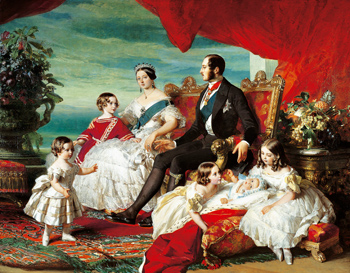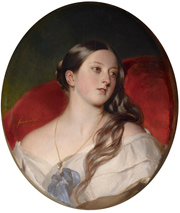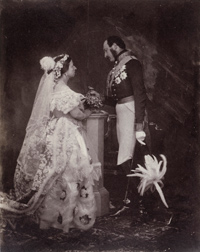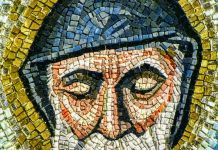A charming exhibition at London’s Queen’s Gallery until 31 October looks at the relationship between Queen Victoria and Prince Albert, from their engagement through to his untimely demise.
 |
| Franz Xaver Winterhalter, The Royal Family in 1846 |
THREE OF THE smallest objects shown in Victoria and Albert: Love and Art at London’s Queen’s Gallery until 31 October are also three of the most evocative in this charming exhibition. Each symbolises the couple’s devotion to each other and their young family. I liked the simple, pebble bracelet made from tiny pieces of agate they’d found on their first journey together in 1841. Prince Albert had the stones sent back to London for polishing and then mounting in gold. It became a tradition on future trips to everywhere from Brighton to Woburn Abbey and each location is engraved on the mount. The second piece I found touching is a winged cherub brooch, inspired by a Raphael painting and designed by Albert. The wings are studded with precious stones, but the cherub’s face is Princess Victoria, their first child. In contrast is a tiny gold and enamel thistle brooch. Its flower is actually the Princess’s first lost milk tooth. On the reverse, an inscription notes that it was pulled by her father at Adverikie (Scotland) on 13 September 1843.
 |
| Queen Victoria’s Costume for the Stuart Ball, 1851 |
Assistant Curator Katherine Jones commented, “Albert often designed jewellery himself and no occasion was left unmarked or unrecorded by the couple in one way or another.” Which is why this fascinating exhibition, which focuses on the period of Victoria’s marriage to Prince Albert, from the time of their engagement in 1839 to the Prince’s untimely death in 1861, covers everything from intimate family occasions and country walks to State occasions and official gifts sparkling with diamonds. Katherine’s particular favourite is the rarely seen Queen’s costume for the Stuart Ball of 1851. Designed by Huguenot artist Eugene Lami in beautiful silks and lace, it’s decorated with faux pearls and silver fringes. “It’s so delicate and sums her up somehow,” she said.
Here are Landseer’s paintings of Eon, Prince Albert’s favourite greyhound – “very friendly if there’s plum cake in the room” wrote the Queen – and the couple dressed as King Edward III and Queen Philippa of Hainault at a Bal Costume in 1842. William Ross’s delicate miniatures on ivory of the young couple are exquisite.
 |
| Winterhalter, Queen Victoria, 1843 |
One painting would probably have shocked her subjects – and it is still considered quite saucy for a royal! Queen Victoria shown with her head tilted provocatively and her brown hair flowing down her shoulder. By Winterhalter, she commissioned it as a surprise birthday present for Albert and it was in his dressing room.
Among the tasteful things on show are their occasional lapses, though fashionable at the time. Few could live with the stag’s horn, hoofs and teeth furniture from the Horn Room at Osborne, the over-the-top German carved writing table, or my particular dislike: the carved marble arms and feet of the Royal children. Awfully creepy.
Arguably the most extraordinary exhibit is the South Indian throne and footstool. Made of elaborately carved ivory and hardwood, set with gold, diamonds, emeralds and rubies, it’s upholstered with embroidered silk velvet. Originally shown in the India section of the 1851 Great Exhibition, it was presented by the Maharajah of Travancore when the Queen became Empress of India in 1876.
Victoria and Albert were very interested in new technology and they especially liked photography. There’s an entire cabinet of carte-de-visite portraits, which would be given to friends and family or arranged in albums by the Queen. In 1860, she posed for some to sell to the public, which were a great success. The couple’s favourite image from the newly formed Photographic Society is also on show: Obaysch the Hippopotumus sleeping at London Zoo!
 |
| Roger Fenton, The Queen and Prince Albert, Buckingham Palace, 1854 |
Among the art exhibits are some delightful and well-executed watercolours of her children by Queen Victoria, watercolours of interiors of the Royal residences and some master works collected by Prince Albert for the Royal Collection. Included here are Frith’s Ramsgate Sands, Cranach’s Apollo and Diana and Landseer’s Isaac van Ambergh and his Animals. The lion tamer was a favourite with Queen Victoria who saw him six times. “One can never see it too often, for it is different each time,” she wrote.
The last part of the exhibition deals with Albert’s death. There is a heart-rending photograph of Victoria gazing mournfully at a bust of Albert while her daughter Princess Alice looks sadly at the camera. It would be another 40 years before she would be laid beside him in the mausoleum she had built at Frognal and this great love story would finally end.
Victoria and Albert: Love and Art is on until 31 October at the Queen’s Gallery, Buckingham Palace Road, London SW1. Tel. (020) 7766 7301; www.royalcollection.org.uk.
Report by Pat Moore
Images: Royal Collection (c) 2009, Her Majesty Queen Elizabeth II






 © 2024
© 2024